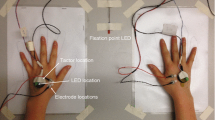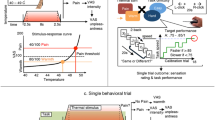Abstract
The effects of instructing subjects to tolerate pain for a fixed amount of time (15 min) versus an unspecified amount of time (“last as long as you can”) was tested using an ischemic pain test. Subjects' latencies to terminate the painful stimulus and their perceived pain intensity ratings were recorded, both before and after cognitive strategy training. Strategy training helped subjects given fixed-time instructions decrease pain ratings and subjects given open-time instructions increase tolerance times. Nevertheless, subjects given specific time goals for tolerating the pain had lower absolute pain ratings and higher tolerance times than subjects given nonspecific goals, whether given strategy training or not. These results suggest that instructional set in and of itself can be therapeutic or deleterious in helping subjects cope with pain.
Similar content being viewed by others
References
Avia, M. D., & Kanfer, F. H. (1980). Coping with aversive stimulation: The effects of training in a self-management context.Cognitive Therapy and Research, 4 73–81.
Bandura, A., & Cervone, D. (1983). Self-evaluative and self-efficacy mechanisms governing the motivational effects of goal systems.Journal of Personality and Social Psychology, 45 1017–1028.
Berkowitz, L., & Donnerstein, E. (1982). External validity is more than skin deep.American Psychologist, 37 245–257.
Fordyce, W. E. (1976).Behavioral methods for chronic pain and illness. St. Louis: C. V. Mosby.
Harris, G., & Rollman, G. B. (1983). The validity of experimental pain measures.Pain, 17 369–376.
Kanfer, F. H., & Goldfoot, D. A. (1966). Self-control and tolerance of noxious stimulation.Psychological Reports, 18 79–85.
Kanfer, F. H., & Seidner, M. L. (1973). Self-control: Factors enhancing tolerance of noxious stimulation.Journal of Personality and Social Psychology, 25 381–389.
Karoly, P., & Jensen, M. P. (1987).Multimethod assessment of chronic pain. New York: Pergamon Press.
Kazdin, A. E. (1979). Nonspecific treatment factors in psychotherapy outcome research.Journal of Consulting and Clinical Psychology, 47 846–851.
Kazdin, A. E. (1980).Research design in clinical psychology. New York: Harper & Row.
Knuckle, C. (1949). Phasic pain induced by cold.Journal of Applied Psychology, 1 468–474.
Maier, S. F., Draugan, R. C., & Grau, J. W. (1982). Controllability, coping behavior, and stressinduced analgesia in the rat.Pain, 12 47–56.
Melzack, R. (Ed.). (1983).Pain measurement and assessment. New York: Raven Press.
Postlethwaite, R., Grieve, N., Santacroce, T., Renfree, L., Wilson, G., & Peck, C. (1980). An analysis of pain produced by submaximum tourniquet test. In C. Peck & M. Wallace (Eds.),Problems in pain: Proceedings of the first Australia-New Zealand conference on pain (pp. 128–135). Sydney: Pergamon Press.
Skinner, B. F. (1953).Science and human behavior. New York: Macmillan.
Smith, G. M., Egbert, L. D., Markowitz, R. A., Mosteller, F., & Beecher, H. K. (1966). An experimental pain sensitive to morphine in man: The submaximal effort tourniquet technique.Journal of Pharmacology and Experimental Therapeutics, 154 324–332.
Smith, G. M., Lowenstein, E., Hubbard, J. H., & Beecher, H. K. (1968). Experimental pain produced by the submaximal effort tourniquet technique: Further evidence of validity.Journal of Pharmacology and Experimental Therapeutics, 163 468–474.
Spanos, N. P., Radtke-Bodorik, H. L., Ferguson, J. D., & Jones, D. (1979). The effects of hypnotic susceptibility, suggestions for analgesia, and the utilization of cognitive strategies on the reduction of pain.Journal of Abnormal Psychology, 88 282–292.
Stevens, R. J., & Heide, F. (1977). Analgesic characteristics of prepared childbirth techniques: Attention focusing and systematic relaxation.Journal of Psychosomatic Research, 21 429–438.
Stevenson, M. K., Kanfer, F. H., & Higgins, J. M. (1984). Effects of goal specificity and time cues on pain tolerance.Cognitive Therapy and Research, 8 415–426.
Strayhorn, J. M. (1987). Control groups for psychological intervention outcome studies.American Journal of Psychiatry, 144 275–282.
Williams, D. A., & Thorn, B. E. (1986). Can research methodology affect treatment outcome? A comparison of two cold pressor test paradigms.Cognitive Therapy and Research, 10 539–546.
Author information
Authors and Affiliations
Additional information
This study was the basis for an undergraduate honors thesis by the second author, Department of Psychology, Ohio State University.
Rights and permissions
About this article
Cite this article
Thorn, B.E., Williams, G.A. Goal specification alters perceived pain intensity and tolerance latency. Cogn Ther Res 13, 171–183 (1989). https://doi.org/10.1007/BF01173271
Issue Date:
DOI: https://doi.org/10.1007/BF01173271




